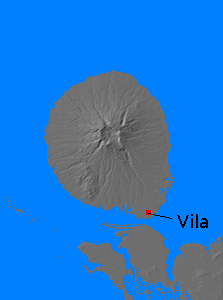![]() The Pacific War Online Encyclopedia
The Pacific War Online Encyclopedia
|
| Previous: Kolar | Table of Contents | Next: Komandorski Islands |

Kolombangara (157.05E
8.0S) is a nearly circular, mountainous island just to the
northwest of New Georgia and
separated from Arundal Island to the south by navigable Blacket Strait.
The island is about 18
miles (29 km) across and its volcanic peak reaches to 5450' (1661
meters). There were just 500 native inhabitants in 1941.
The Japanese built an airstrip at Vila on the southeast
coast of the island in early 1943 and garrisoned the island with 2000
men from 7 Yokosuka SNLF
and a battalion of 51 Division on 23 February
1943. The Army battalion was relieved by a battalion from 6 Division in April.
The Japanese expected the Americans to land on
Kolombangara and advance from there to New Georgia, but the Americans
attacked New Georgia first and subsequently bypassed Kolombangara by
landing at Vella
Lavella, which was only
weakly defended. The Japanese began evacuating Kolombangara in October
1943, losing a number of ships,
and elements of 27
Regiment occupied Vila on 10 October. The airfield was closed in
early 1945.
On the night of 12-13 July the Japanese dispatched1200 troops by destroyer-transports to New Georgia. The move was picked up by Allied intelligence and Ainsworth was dispatched from Tulagi to intercept. For this operation, his task force was assigned six additional destroyers by Turner. Ainsworth's battle plan was to send the van destroyers to fire torpedoes, close to engage with gunfire before the enemy can react, then turn away to avoid enemy torpedoes.
Allied air cover prevented a Japanese sighting of Ainsworth's force, while "Black Cat" Catalinas tracked the Japanese force coming down "The Slot." Radar contact was established at 0100 on 13 July and confirmed visually a few minutes later. At 0109 the order was given for the van destroyers to fire torpedoes. But the Japanese had detected the Allied radar emissions using a new radar detector, and had already spotted the Allied ships at 0108. Jintsu turned on her searchlights and opened fire with guns and torpedoes. The Allied cruisers also opened fire, using FC radar fire control and spotting from the "Black Cats." Jintsu was quickly smothered by shells and put out of action. By 0145 she had taken two torpedoes and sank with almost all hands, including her captain and Admiral Izaki.
It was now time to turn away to avoid enemy torpedoes, but communications were poor and the movement was executed sloppily. Leander was hit by a torpedo that killed 28 sailors and put her out of the battle. Other ships had very close calls.
The "Black Cats" reported four destroyers heading north, and Ainsworth detached Destroyer Squadron 21 to pursue. The Japanese had, in fact, ducked into a convenient rain squall to reload their torpedo tubes. Ainsworth soon had most of his force racing up "The Slot" but his force was disorganized and there was real danger of a friendly fire incident in the confusion. Radar detected two targets, but it took several minutes to decide that they were likely enemy ships. By then the Japanese had fired their torpedoes and were retiring. Ainsworth's force steamed directly into the path of the Long Lances and at 0208 St.Louis was hit well forward. Honolulu maneuvered violently but was hit at the very tip of her bow, and a dud torpedo hit aft. Destroyer Gwin was caught square in the engine room and suffered an immediate secondary explosion. Only Ralph Talbot was able to locate a target, and fired torpedoes at 0213. All missed.
Gwin
was scuttled at 0930. As the remaining Allied ships returned down "The
Slot", a force of 18 Vals and 20 Zeros tried to attack but were
driven off by fighters from the Russell Islands.
All the Allied cruisers had
been hit well forward and were relatively lightly damaged. However, the
cruisers were taken in hand for lengthy refitting, during which the
American ships had their 1.1"
guns replaced with 40mm
Bofors mounts.
The Japanese destroyer-transports reversed course as soon as the battle opened, and they were able to land 1200 troops on the west coast of Kolombangara before withdrawing.
Ainsworth later wrote to Nimitz
that "Looking over one's shoulder, one can always see how we should
have done differently, and no one knows the fallacy of chasing Jap
destroyers with cruisers better than I." The Americans were slowly
learning. Nimitz replied that "You have fought two hard actions
featured by aggressiveness and tactical skill," and Ainsworth continued
to serve in combat commands until 1945.
| Task
Force 18 (Ainsworth)
|
|||
| |
Destroyer
Squadron 21 |
||
| |
DD Nicholas |
||
| DD O'Bannon | |||
| DD Taylor | |||
| DD Jenkins | |||
| DD Radford | |||
| Cruiser
Division 9 (Ainsworth)
|
|||
| CL Honolulu |
Slightly damaged |
||
| CL Leander |
Damaged |
||
| CL St.Louis |
Damaged |
||
| Elements,
Destroyer Squadron 12 |
|||
| DD Ralph
Talbot |
|||
| DD Buchanan |
|||
| DD Maury |
|||
| DD Woodworth | |||
| DD Gwin | Sunk |
||
| Support
Group (Izaki)
|
Killed in action |
|
| |
CL Jintsu |
Sunk |
| DD Mikazuki |
||
| DD Yukikaze |
||
| DD Hamakaze | ||
| DD Kiyonami |
||
| DD Yugure |
||
| APD Satsuki | ||
| APD Minazuki | ||
| APD Yunagi |
||
| APD Matsukaze | ||
References
The Pacific War Online Encyclopedia © 2007-2008, 2010, 2014 by Kent G. Budge. Index